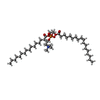+検索条件
-Structure paper
| タイトル | Structural mechanism of heat-induced opening of a temperature-sensitive TRP channel. |
|---|---|
| ジャーナル・号・ページ | Nat Struct Mol Biol, Vol. 28, Issue 7, Page 564-572, Year 2021 |
| 掲載日 | 2021年7月8日 |
 著者 著者 | Kirill D Nadezhdin / Arthur Neuberger / Yuri A Trofimov / Nikolay A Krylov / Viktor Sinica / Nikita Kupko / Viktorie Vlachova / Eleonora Zakharian / Roman G Efremov / Alexander I Sobolevsky /    |
| PubMed 要旨 | Numerous physiological functions rely on distinguishing temperature through temperature-sensitive transient receptor potential channels (thermo-TRPs). Although the function of thermo-TRPs has been ...Numerous physiological functions rely on distinguishing temperature through temperature-sensitive transient receptor potential channels (thermo-TRPs). Although the function of thermo-TRPs has been studied extensively, structural determination of their heat- and cold-activated states has remained a challenge. Here, we present cryo-EM structures of the nanodisc-reconstituted wild-type mouse TRPV3 in three distinct conformations: closed, heat-activated sensitized and open states. The heat-induced transformations of TRPV3 are accompanied by changes in the secondary structure of the S2-S3 linker and the N and C termini and represent a conformational wave that links these parts of the protein to a lipid occupying the vanilloid binding site. State-dependent differences in the behavior of bound lipids suggest their active role in thermo-TRP temperature-dependent gating. Our structural data, supported by physiological recordings and molecular dynamics simulations, provide an insight for understanding the molecular mechanism of temperature sensing. |
 リンク リンク |  Nat Struct Mol Biol / Nat Struct Mol Biol /  PubMed:34239124 / PubMed:34239124 /  PubMed Central PubMed Central |
| 手法 | EM (単粒子) |
| 解像度 | 1.98 - 3.86 Å |
| 構造データ | EMDB-23853, PDB-7mij: EMDB-23854, PDB-7mik: EMDB-23855, PDB-7mil: EMDB-23856, PDB-7mim: EMDB-23857, PDB-7min: EMDB-23858, PDB-7mio: |
| 化合物 |  ChemComp-POV:  ChemComp-NA:  ChemComp-HOH: |
| 由来 |
|
 キーワード キーワード | MEMBRANE PROTEIN / Transient Receptor Potential V Family Member 3 / TRP channel / TRPV3 / closed state at 4 degrees Celsius / MSP2N2 / closed state at 42 degrees Celsius / sensitized state at 42 degrees Celsius / cNW11 / open state at 42 degrees Celsius |
 ムービー
ムービー コントローラー
コントローラー 構造ビューア
構造ビューア 万見文献について
万見文献について
















